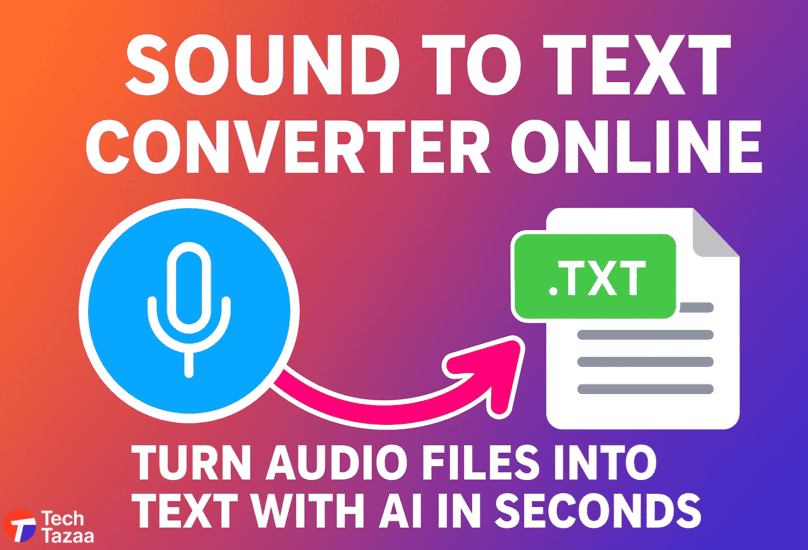Have you noticed that more than eighty (80%) of the activities we participate in online is video or audio-based? Podcasts, online lectures, business meetings, and simply watching YouTube videos are the top forms of consumption in digital content. Despite this fact, text is still the ultimate king of a person with accessibility, and text is what remains king of search (SEO).
This is where sound to text converter online tools are useful. Whether you are a student trying to transcribe lectures, a business professional trying to document meetings, or a content creator trying to repurpose podcasts into a blog, these types of tools will save you hours in time and effort.
In this guide, we’ll explore:
- What a sound to text converter online is and how it works.
- The role of AI audio to text converters in improving speed and accuracy.
- Benefits and challenges of using these tools.
- The best tools in 2025 for transcribing audio files to text.
- Step-by-step instructions and use cases.
- The exciting future of AI-powered transcription.
By the end, you’ll know exactly how to turn audio files into text with AI in seconds—and which tool fits your needs best.
What Is a Sound to Text Converter Online?
An sound to text converter online is an online tool that takes spoken speech in any audio file and turns it into text.
In the past, transcription relied on manual labor: you would listen to a recording and type it out, which was laborious, slow, and incidentally wrong. But with our AI-powered audio to text software, this is the hard work.
Key Benefits:
- Speed: Convert a 60-minute file in just minutes.
- Affordability: AI transcription is far cheaper than human services.
- Accessibility: Helps the deaf and hard of hearing, and makes content searchable.
👉 In short: These tools make content smarter, searchable, and accessible, whether it’s for work, study, or creativity.
How Does an Audio to Text Converter AI Work?
Behind the scenes, an audio to text converter AI relies on Automatic Speech Recognition (ASR) and Natural Language Processing (NLP).
Here’s a simple breakdown:
- Upload Audio File: MP3, WAV, MP4, or another supported format.
- Speech Detection: AI analyzes sound waves and identifies speech patterns.
- Language Processing: NLP models understand grammar, accents, and context.
- Text Output: AI generates readable, structured text—ready to edit or publish.
Why AI Is Better Than Manual Transcription:
- Learns from millions of speech samples for accuracy.
- Recognizes multiple languages.
- Adapts to industry-specific jargon (medicine, law, tech).
👉 Keywords like audio file converter to text highlight that today’s tools aren’t just convenient—they’re remarkably accurate and scalable.
Benefits of Using an Audio File Converter to Text Online
Still wondering if you should use one? Let’s dive into the biggest benefits.
1. Time-Saving
- Transcribe a 2-hour lecture in minutes.
- Perfect for journalists, students, and professionals.
2. Cost-Effective
- Human transcription: $1–$2 per audio minute.
- AI transcription: often free or under $10 per hour of audio.
3. Multilingual Support
- Tools like Google Speech-to-Text recognize 100+ languages and dialects.
- Ideal for global businesses and international creators.
4. Accessibility & SEO
- Transcripts make your content searchable on Google.
- Subtitles improve YouTube engagement by up to 80%.
- Expands reach to hearing-impaired audiences.
👉 Whether you call it an audio file converter to text or audio converter to text online, the outcome is the same: faster, cheaper, and more inclusive communication.
Best Sound to Text Converter Online Tools (2025 List)
There is no shortage of transcription tools on the market. The difference lies in whether the tool has been built for speed, accuracy, or some combination thereof. Some tools have advanced features such as real-time collaboration and editing for video. In any case, here’s a deeper assessment of the best sound-to-text converter online tools in 2025.
1. Google Speech-to-Text
One of the most powerful AI transcription engines, built on Google Cloud’s deep learning models.
- Key Features:
- Recognizes 120+ languages and dialects.
- Real-time transcription with automatic punctuation.
- Works with both live audio and pre-recorded files.
- Integrates with apps and platforms via API.
- Recognizes 120+ languages and dialects.
- Pricing: Pay-as-you-go (~$0.006 per 15 seconds of audio).
- Pros: High accuracy, scalable, multilingual.
- Cons: Requires some technical setup; not as beginner-friendly.
- Best For: Developers, enterprises, global companies.
2. Otter.ai
A popular choice for students, teams, and professionals who want fast, real-time transcription.
- Key Features:
- Real-time transcription during meetings and lectures.
- Speaker identification and collaboration notes.
- Syncs with Zoom, Google Meet, and MS Teams.
- Searchable transcript library with highlights.
- Real-time transcription during meetings and lectures.
- Pricing: Free plan (300 monthly minutes); Pro plan starts at ~$16.99/month.
- Pros: Easy to use, strong collaboration features.
- Cons: Limited free minutes, less suited for very long files.
- Best For: Students, educators, small teams.
3. Rev.ai
A hybrid platform offering both AI transcription and human transcription for maximum accuracy.
- Key Features:
- AI transcription (fast and affordable).
- Human transcription with 99% accuracy guarantee.
- Custom vocabulary for technical terms.
- API access for developers.
- AI transcription (fast and affordable).
- Pricing:
- AI transcription: $0.035 per audio minute.
- Human transcription: $1.50 per audio minute.
- AI transcription: $0.035 per audio minute.
- Pros: Extremely accurate with human option, professional-grade.
- Cons: Costs add up quickly with longer files.
- Best For: Journalists, legal, medical, and enterprise users.
4. Descript
A unique tool that goes beyond transcription—combining audio, video editing, and text transcription.
- Key Features:
- Overdub (AI voice cloning).
- Podcast & video editing with transcript-based workflow.
- Screen recording + editing in one tool.
- Real-time collaboration for teams.
- Overdub (AI voice cloning).
- Pricing: Free plan available; Creator plan at $12/month; Pro at $24/month.
- Pros: Multi-purpose, great for content creators.
- Cons: Learning curve; heavy on system resources.
- Best For: Podcasters, YouTubers, video editors.
5. Sonix.ai
A powerful online transcription service designed for professionals and businesses.
- Key Features:
- Automatic transcription with timestamps.
- Multi-user collaboration.
- Advanced export options: DOCX, SRT, PDF.
- Custom dictionaries for improved accuracy.
- Automatic transcription with timestamps.
- Pricing: $10/hour of audio or $23/month subscription.
- Pros: Professional-grade accuracy, versatile formats.
- Cons: Subscription pricing can be expensive for casual users.
- Best For: Businesses, professionals, and enterprises.
Free Tools (oTranscribe, Bear File Converter, etc.)
For those who need basic transcription without paying, these tools are good starting points.
- Key Features:
- Simple, browser-based transcription.
- No sign-up required.
- Works best with clear audio files.
- Simple, browser-based transcription.
- Pricing: 100% free.
- Pros: Zero cost, easy to use.
- Cons: Lower accuracy, no advanced features, limited formats.
- Best For: Casual users, students with small projects.
Comparison Table (Updated 2025)
Tool | Languages | Free Plan | Accuracy | Pricing Model | Best For |
Google STT | 120+ | No | High | Pay-as-you-go | Developers, enterprises |
Otter.ai | 30+ | Yes | High | Subscription | Students, teams |
Rev.ai | 30+ | No | Very High | Pay-per-minute | Journalists, professionals |
Descript | 20+ | Yes | High | Subscription | Podcasters, creators |
Sonix.ai | 40+ | Trial | High | Pay-per-hour | Businesses, enterprises |
Free Tools | Limited | Yes | Medium | Free | Casual, light use |
How to Choose the Right Audio Converter to Text Online
Not all tools are created equal. Here’s what to look for:
- Accuracy: Look for AI powered by deep learning.
- Supported Formats: Ensure it works with MP3, WAV, MP4, and more.
- Pricing: Free tools are fine for small tasks; paid ones suit businesses.
- Language Support: Global creators need multi-language options.
- Extra Features: Live transcription, editing, team collaboration.
👉 Tip: If you’re starting out, try Otter.ai (free plan) or Sonix (trial) before committing.
Step-by-Step: How to Convert Audio Files to Text Using AI
Follow this simple process:
- Upload your audio file (MP3, WAV, MP4, etc.).
- Select language and transcription preferences.
- Let AI process: This takes a few seconds to a few minutes.
- Download or copy text: Export as TXT, DOCX, or SRT (subtitles).
👉 Pro Tip: Clean audio = higher accuracy. Avoid background noise!
Common Use Cases for Audio to Text Converter AI
Who benefits most?
- Students: Convert lectures into notes.
- Journalists: Quickly transcribe interviews.
- Businesses: Document meetings, create reports.
- Content Creators: Generate captions & repurpose podcasts into blogs.
- Accessibility: Provide subtitles for the hearing-impaired.
👉 The beauty of a sound to text converter online is that it adapts to multiple industries.
Limitations & Challenges of AI Audio Converters
AI is powerful, but not perfect.
- Accents & Background Noise: Accuracy drops in noisy environments.
- File Size Limits: Free tools often cap uploads.
- Privacy Risks: Be careful when uploading sensitive data.
- Context Understanding: Struggles with slang, humor, or sarcasm.
👉 While audio converters to text online are fast, they still require human proofreading.
Future of Audio to Text Converter AI
The future is exciting. Expect:
- Real-Time Translation: Speak in English, get instant text in Spanish.
- Deeper Accuracy: Thanks to advanced deep learning.
- Integration into Devices: Smartphones, wearables, smart assistants.
- Industry Adoption: Legal, medical, and business sectors going fully AI-powered.
👉 Prediction: By 2030, AI transcription will be standard in every digital workflow.
Conclusion: Turn Audio Files into Text with AI in Seconds
Converting audio to text used to be time-consuming and expensive. But thanks to sound to text converter online tools, anyone can now turn audio files into text in seconds with AI accuracy.
We covered:
- What these tools are and how they work.
- Benefits, best tools, and how to choose wisely.
- Practical use cases and limitations.
- Future trends that will reshape transcription forever.
Don’t waste hours typing. Start using a reliable audio to text converter AI today—whether it’s for study, business, or content creation. Try one of the recommended tools and make your workflow smarter, faster, and more accessible.
FAQs About Sound to Text Converter Online
- What is the best free sound to text converter online?
Free services (like oTranscribe and Bear File Converter) are suitable for basic needs, but if you don’t mind spending a little extra for higher accuracy, Otter.ai (free plan) and Google Speech-to-Text may be what you’re looking for.
- How accurate is an audio to text converter AI?
For audio to text AI converters, expect a typical limit of 85-95% accuracy, depending on quality of audio, background noise, and accents. The cleaner the recording, the better.
- Can I convert long audio files to text online?
Yes, many tools support long files. Premium tools like Sonix.ai and Rev.ai allow large uploads, while free tools may limit file size.
- Is it safe to use an audio file converter to text online?
Yes—if you use trusted platforms. Always check a tool’s privacy policy before uploading sensitive data. Paid solutions usually offer better data security.
- Which file formats do audio converters to text online support?
Most tools accept MP3, WAV, M4A, and MP4. Advanced platforms also support less common formats like FLAC or OGG.
- Can AI audio to text converters recognize multiple languages?
Certainly. Well-known programs like Google Speech-to-Text and Sonix can recognize dozens of dialects and languages, which makes them helpful for global customers.
- Do I need to edit transcripts generated by AI?
Even the best audio to text converter, which uses AI technology, can make mistakes interpreting words (particularly slang, vocabulary specific to technical fields, and audio that has background noise). A quick read through ensures the correct interpretation of words.
- How can businesses use sound to text converter online tools?
Businesses repurpose these programs for meeting notes, training transcripts, call logs, legal documents, or other types of content (podcasts to blog posts, etc).


